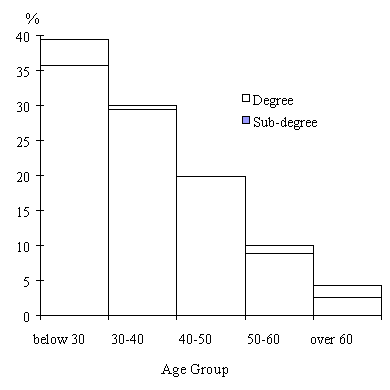Chapter 31: Numbers 2001-2006
| 31.1 | In the absence of government manpower supply and demand projections beyond 2001, the numbers required within higher education for the second half of our decade are necessarily more speculative. The shift from manufacturing to service sector activities is likely to continue but, as by 2001 four out of every five workers will already be in service industries, the scope for major impact on employment will diminish. More interesting is the extent to which, within the service-dominated economy, employment will become knowledge-based. It seems probable that knowledge-based activity will increase very markedly, but there are differing views on whether the "knowledge" and its manipulation will require more sub-degree, technician and craft labour or increased numbers of degree graduates. |
| 31.2 | The skilled labour force in 2001 will be relatively young (Figure 31.1, based upon MR). Losses due to retirement in the period 2001-2006 will thus be quite small, even when one allows for decreasing retirement age. If we add to retirement all other causes internal to Hong Kong, we might perhaps expect to lose 10% of the labour force or 32,000 graduates and 18,000 holders of sub-degree qualifications. The effects of emigration and immigration are very difficult to predict so far ahead, but at present they are roughly self-balancing and we shall assume that they will remain so. The supply from within Hong Kong, assuming no change in provision, will be about 60,000 graduate and 35,000 sub-degree holders, so that gains are twice the losses, even before one comes to external provision, which at current rates might be 26,000 returned graduates and 10,000 returned sub-degree holders. |
| 31.3 |
Even allowing for growth of demand for high level skills in the economy, there seems to be little argument at present for substantially increasing initial higher education provision in Hong Kong up to 2006 (except perhaps in some VTC institutions), unless the immigration / emigration balance turns adverse. It must be remembered, however, that we only have population projections to 2001 (Table 30.4). An important consideration here, also, is the extent to which Hong Kong's HEIs may in future contribute to regional manpower needs, particularly within China. We discuss this further in Chapter 33. The position for CPE (see Section E) is very different from that for initial higher education, and we anticipate and would encourage continuing growth. Figure 31.1 Age Distribution of Holders of Degree and |
 | |
Source: Manpower 2001 Revisited (EMB 1994) | |